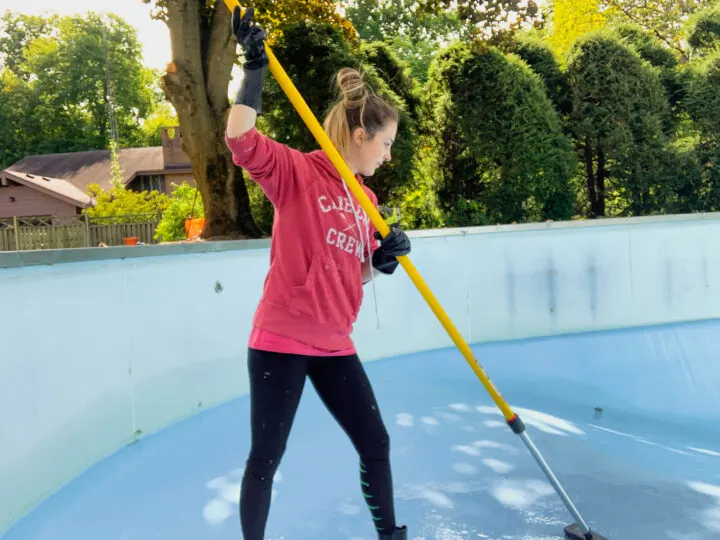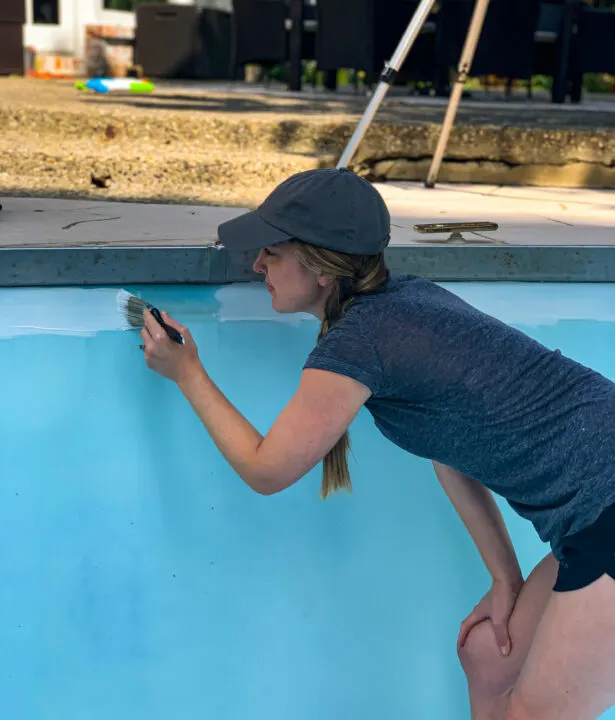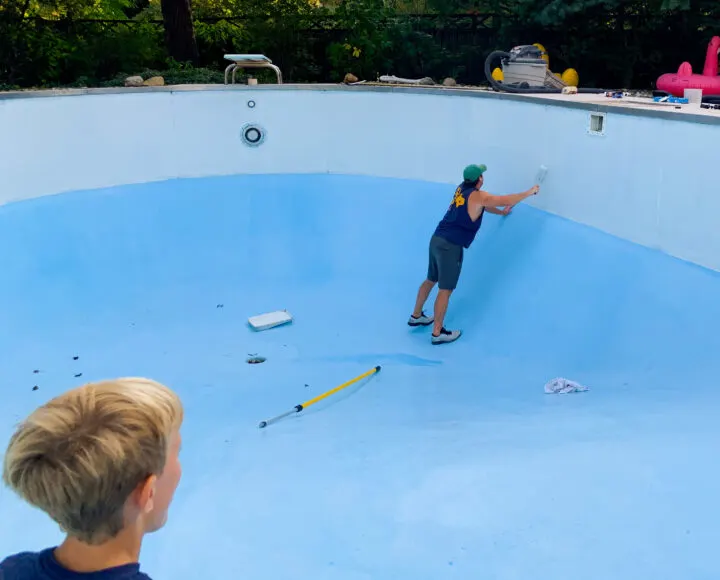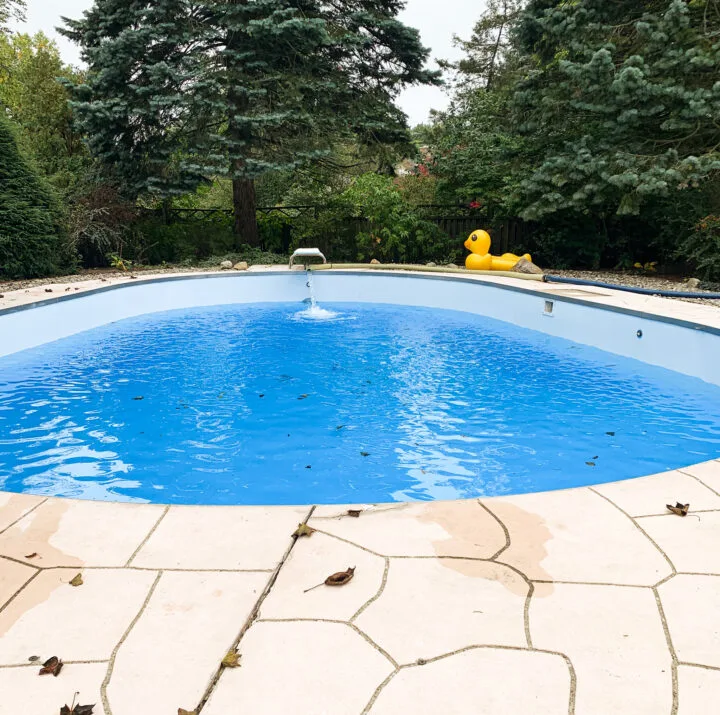Last Updated on June 6, 2024 by lindseymahoney
Imagine the satisfaction of diving into a pool that you’ve personally transformed! Even better, imagine what you can do with all of the money you saved by painting your swimming pool yourself! If you’re feeling daunted by the idea of tackling this project, fear not. This step-by-step guide on “how to paint a swimming pool with epoxy paint” is here to make this DIY adventure enjoyable and easy!

With the right tools, tips, and a splash of confidence, you’ll be painting your pool like a pro. Let’s get started!
Table of Contents
- Back Story
- Project Source List:
- How to Paint a Swimming Pool Yourself
- 1 | Drain the Pool
- 2 | Acid Wash the Surface of the Pool
- 3 | Apply Primer to Bare Fiberglass Walls
- 4 | Apply White Epoxy Paint Over Primer on the Walls
- 5 | Paint the Bottom of the Pool
- 6 | Fill the Pool with Water
- Painted Pool Reveal
- Frequently Asked Questions
- More Outdoor Projects You Will Love
Back Story
Would you believe me if I told you we almost walked away from our house because there was a swimming pool in the backyard?
When we purchased the house, our kids were 2 and 6, so the idea of becoming pool owners was very intimidating. I was scared that our kids could drown and concerned about pool maintenance costs. In the end, we decided to buy the home and I quickly grew to love our swimming pool.

The first summer owning a pool, we relied heavily on a professional company to maintain it. After watching them open/close and clean the pool for a year, we felt confident that we could take over and save money in the process. There was a little bit of a learning curve but pretty quickly we learned how to open and close the pool ourselves and how to keep it clean.
A year after we moved in, our 1970s concrete pool needed to be repainted. A pool company came out and quoted us over $5,000 to paint the pool!
Painting projects have never scared us so we quickly decided to DIY this project ourselves and save on labor costs. It’s funny how just one year earlier I didn’t even want to own a pool and now I was planning to paint it!
What is Epoxy Paint?
Epoxy paint is the mixture of latex acrylic paint and little bit of epoxy to create a more durable paint material.
Why Choose Epoxy Paint?
Epoxy paint is the best option for swimming pools because of its durability, resistence to UV rays and chemicals. Epoxy paint is also popular for high traffic areas like garage floors and concrete basement floors.
Project Source List:
Must-Have Tools
- Deck Scrub Brush
- Submersible Pump
- Rubber Gloves
- Chemical Sprayer
- Shop-Vac (owned)
- Roller Sleeve & Roller Cage
- Paint Brushes
- Paint Mixer Attachment
- Extension Pole
- Paint Tray & Tray Liners
Pool Paint Materials
- Smart Seal Primer: For bare walls
- Smart Seal Premium Epoxy One Coat Pool Coating: White paint for walls
- Premium Epoxy One Coat Pool Coating: Blue Heaven paint for floors
- Prep Wise Clean & Etch 1-Step Surface Preparation
Tip: Consult local pool experts: Before tackling this big project I highly recommend talking it over with an expert at your local pool store. For us, that was Leslie’s Pool store and they advised us on the best paint materials to use for our specific pool type.
How to Paint a Swimming Pool Yourself
[Affiliate links are used in this post, thanks for supporting Building Bluebird!]
1 | Drain the Pool
The first step with this project is to remove the pool water. We rented a submersible pump to speed up the process.

We dropped it into the center of the deep end and rolled the hose towards the street. Once the pump got started, it took about 12 hours to empty our pool.
If you live in Toledo, Ohio, we rented the pump from Great Lakes rental & equipment services.

When the water was lower than the suction of the pump, we used a squeegee to push the water toward it.

Next, we used the wet vac to remove any standing water and debris from the bottom of the pool.

2 | Acid Wash the Surface of the Pool

Before applying a fresh coat of paint, you want to remove as much of the dirt and grime from the pool surface. We used reasonable caution during this process and wore rubber gloves to protect our skin from the chemicals.
We chose an acid washing product that easily cleans and etches the surface of the pool to ensure paint adhesion. The Smart Seal Clean & Etch acid solution came recommended by our local pool store and we followed the manufacturer’s directions. It can be used on bare concrete, gunite, marcite, bare fiberglass, plaster, and painted surfaces (follow instructions for proper dilution).

First, we sprayed the sides of the pool and used a deck brush to scrub the walls so that the dirt drained down to the bottom of the pool. We used the hose to rinse the walls and remove all of the cleaning solution.

Next, I wet the bottom of the pool shell using our garden hose and sprayed the solution until it began to foam. I used a deck scrub brush to remove the dirt and then rinsed it away using the hose. To remove the dirty water from the bottom of the pool, we used the submersible pump again.
The goal was to remove as much debris and flaking material as possible, not to remove every stain. Let the surfaces of the pool completely dry before applying new paint.
3 | Apply Primer to Bare Fiberglass Walls

The walls of our pool are made of fiberglass and have never been painted. We first had to apply a primer to the walls to ensure the epoxy paint would adhere properly.
We used a high build epoxy primer made to smooth out rough surfaces. Like the finish paint, It is a 2 part catalyst system that requires you to mix the two cans together thoroughly before painting.

Chris researched tips online for painting a pool and many recommended mixing in a 5-gallon bucket.
We tried it in the bucket and then we tried mixing the epoxy right into the gallon can. Both work fine, but I actually prefer using the gallon can because there is less mess.
The problem with the bucket was trying to reuse it. The paint becomes chunky quickly and it is not easy to clean for reuse. Mixing in the paint required more focus to prevent spills, but is easier in my opinion.

Apply one coat of primer and let it cure for 24 hours or overnight.
4 | Apply White Epoxy Paint Over Primer on the Walls

The next day we applied the white epoxy paint to the walls. We mixed the two part epoxy the same way as the primer. A paddle paint mixer attachment on a drill makes mixing the paint into a smooth consistency much easier than a handheld stir stick.
We followed the product directions and they recommended application within one hour of when you mix the paint and epoxy together. The paint is a little tricky because it is thicker than normal latex paint.
We found the best way to apply the epoxy coating quickly was to work together. Chris rolled the paint and I trimmed the edges of the pool walls.

The kids LOVED this project and were super excited to run around the empty pool. They both wanted to help with the painting too.
When Chris and I couldn’t paint together, I found that the best process was to work in small sections. I rolled two panels and then quickly trimmed them out with the paintbrush.
Because the paint is thicker, I recommend checking your work after 10 minutes to clean up any dripping paint. If you see paint starting to sag down the wall, use the paint roller to clean up the drips.
When trimming the edges, I was careful painting around the top edge. At the bottom of the wall, I didn’t worry about painting straight since I needed to cut in the blue paint on the floor.
Let the paint dry overnight.
5 | Paint the Bottom of the Pool

The bottom of the pool was already painted a light blue. We chose a slightly darker blue paint color called Blue Heaven. We chose a glossy finish that should last up to 8 years.
This type of pool paint only requires one coat which I was excited about!

I started by cutting the edge with a paintbrush where the floor met the white walls.
It was definitely not a perfectly straight line, but it won’t be noticeable underwater.

We started in the deep end of the pool and used a paint roller to apply the epoxy paint. We worked our way up to the shallow end so that we did not get stuck at the bottom of the pool!

I worked my way to the steps of the pool and finished pretty quickly.

6 | Fill the Pool with Water

Once the painting was complete, we let the paint cure for 5 days before filling it back up with water.
Even though we are about to close up the pool for the winter, it is important to fill it with water to prevent damaging the pool surface.
If the pool stays empty, the walls or floor can get damaged from the thawing and freezing of the earth around the pool.
The most cost-effective way for us to have our pool filled was by calling a company to have it delivered. This option is less expensive and faster than filling your pool with a garden hose.
The pool is almost ready to close since we cleared the drain lines and removed the ladder before painting the pool. The only remaining item left is attaching the pool cover over top.
Painted Pool Reveal

*Check out before and after images of our backyard pool makeover!

I am absolutely tickled with the final product of this DIY project, I feel like we have a new pool!

Old pools can absolutely be brought back to life with a little love and attention. With some careful planning and the proper materials, you too can paint your pool yourself and save some money! Good luck!

TIP: When we open the pool next spring, we will need to fill in more water. I was told that if you call the water company and tell them this is happening, they will charge you less for the water used to fill your pool. I love tips that will save me money!
Frequently Asked Questions
Would you change anything about this project if you could do it again?
If I redid this project, I would choose a different paint sheen for the bottom of the pool. The glossy finish was a little slick the first year and I was quite nervous when people took their first step into the pool.
When is the best time to paint a pool?
You want to avoid painting your pool when there is a chance the temperature can dip below 40 degrees. It is also a good idea to check the weather forecast to ensure there isn’t rain in the coming days. Avoid painting your outdoor pool when there are high winds because leaves and debris will get stuck in your wet pool paint.
How often does a pool need to be painted?
If you have an unlined pool, it will require maintenance of some sort. The swimming pool paint we use is supposed to last 8 years and then it is recommended that it be repainted. If you take good care of your pool, the paint will last longer.
We painted our pool 5 years ago and there are a few paint chips on the bottom of the pool but nothing glaringly obvious.
How much paint do I need to paint a pool?
This will depend on the size of your pool. Collect the measurements of your pool and reference the paint can to see how much coverage you will get per can.
What is the best paint to use on a swimming pool?
I have only used epoxy paint for our pool and it is one of the more common types of paint used because of its durability. A few other paint types that are frequently used to paint pool deck and pools are rubber-based paint and acrylic pool paint.
More Outdoor Projects You Will Love
- How to Add a Charming Brick Border to a Flower Bed
- 21 Stunning Garden Shed Ideas for Your Backyard
- How To Create A Beautiful English Cottage Garden
- My Favorite Tools I Recommend to New Gardeners
- How to Camouflage Your Electrical Meter | DIY
- Beautiful Perennial Plants You Can Divide & Transfer
- 25+ Easy Outdoor DIY Projects to Try This Year

